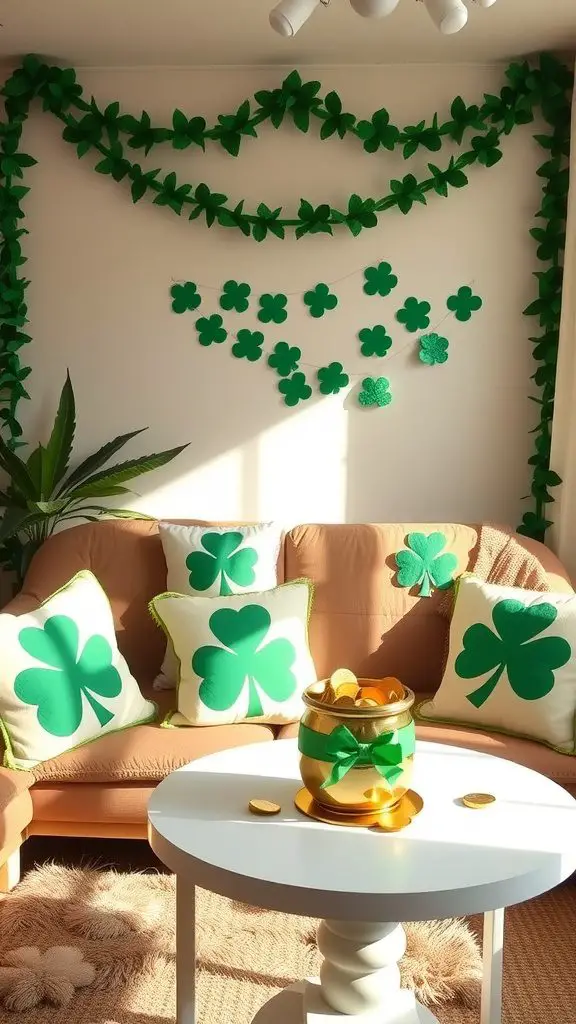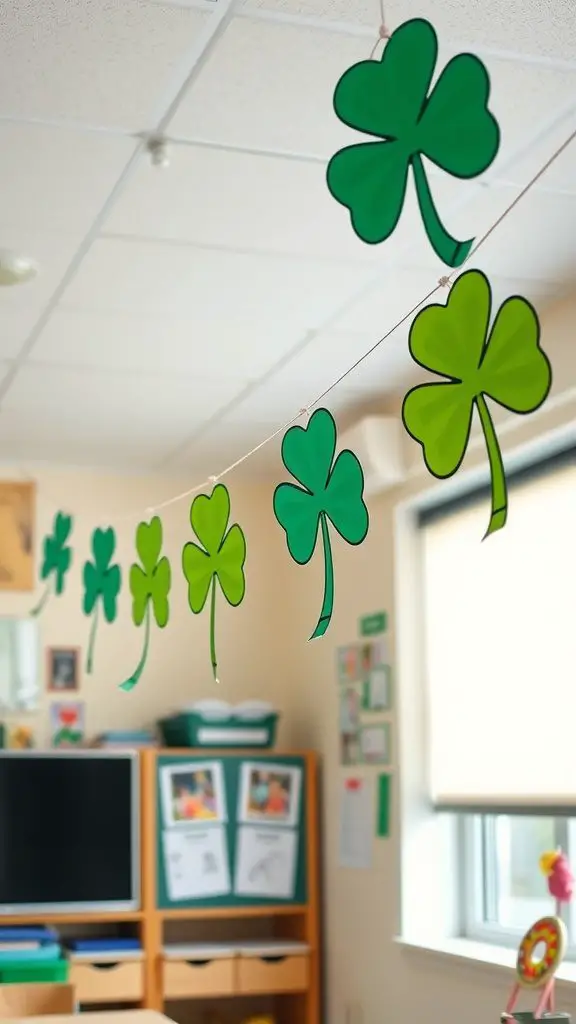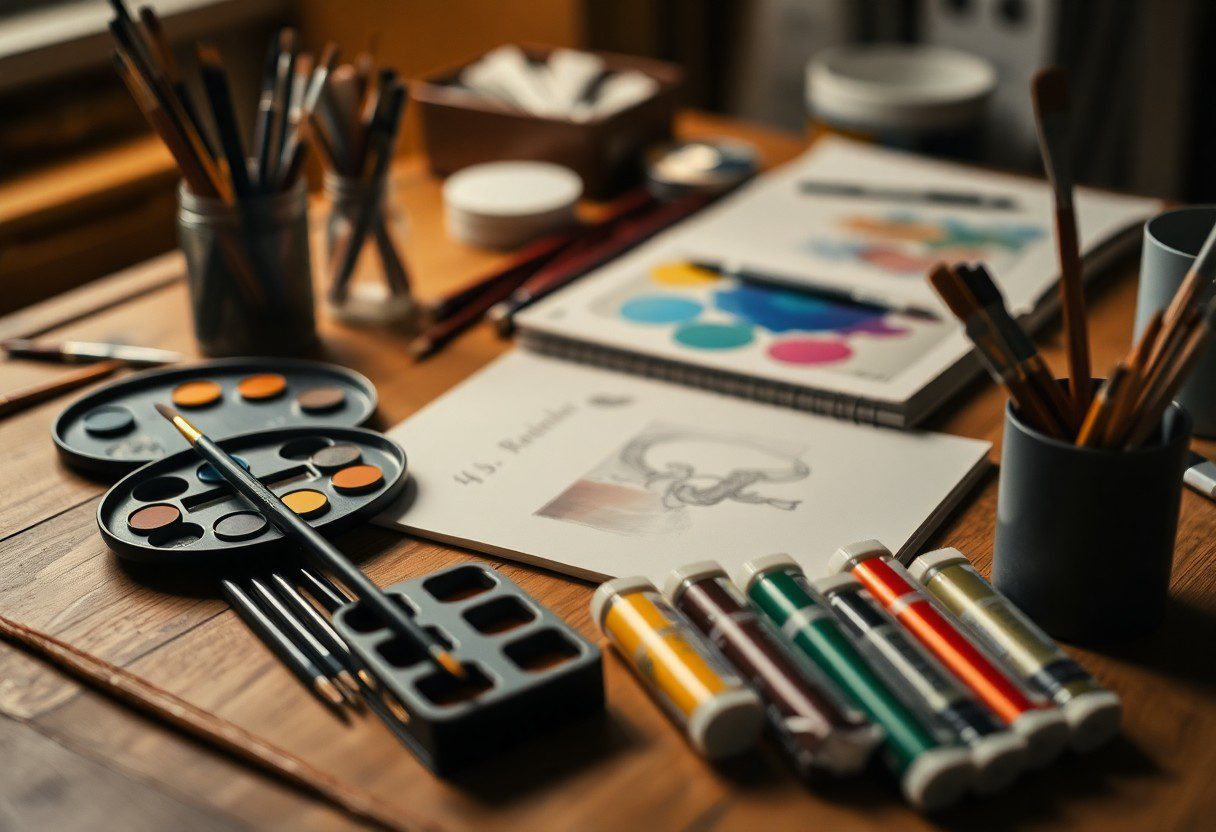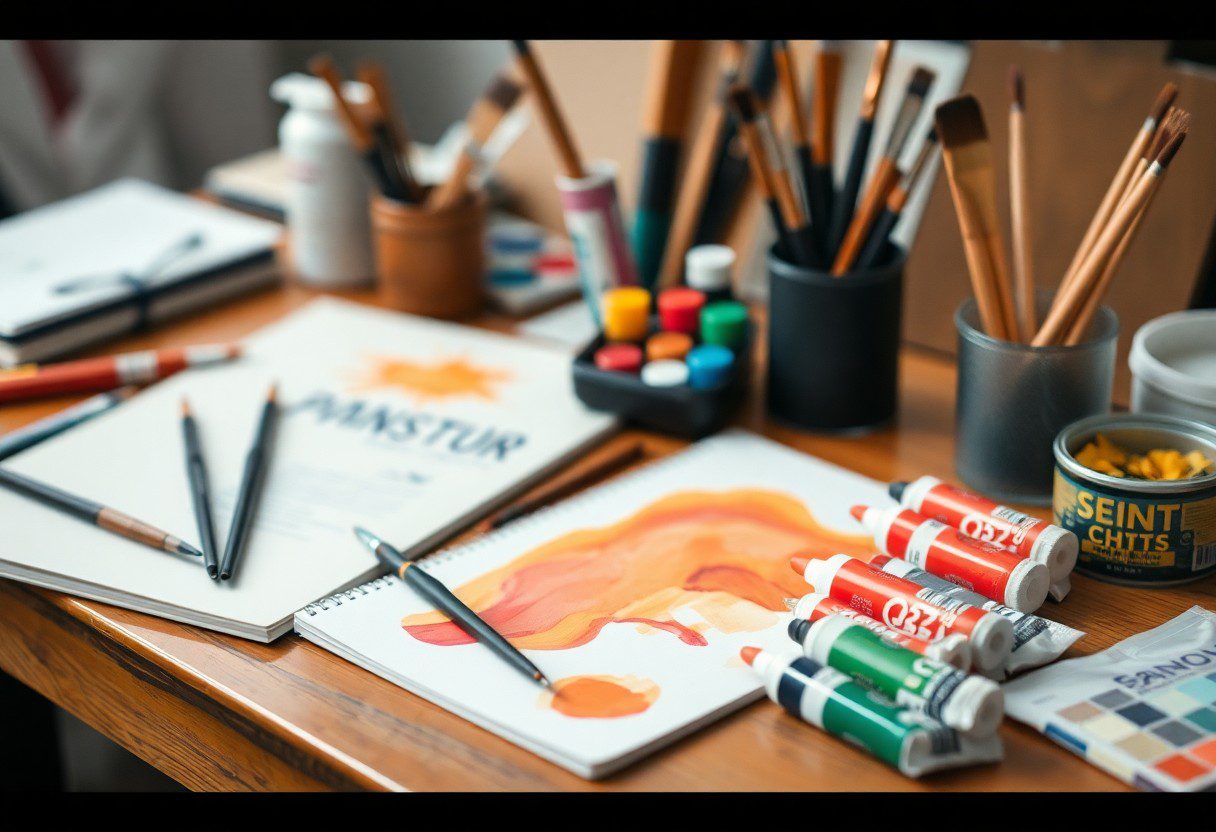Just as every great artist starts with basic tools, you too can build a solid foundation in your artistic journey by mastering necessary techniques. From understanding color theory to exploring different mediums, this guide will equip you with the knowledge needed to elevate your skills. You will discover how to create depth and texture in your artwork, ensuring a transformative experience as you express your creativity. Whether you are picking up a brush for the first time or honing your existing skills, these fundamental art techniques will enhance your artistic prowess.
Understanding Art Materials
Your art journey begins with an exploration of various art materials available to you. Understanding these materials will enhance your creative expression and help you choose the right tools for your artistic endeavors. Whether you’re a painter, sketch artist, or mixed media creator, familiarizing yourself with your supplies is vital for effective art-making.
Types of Brushes
- Round Brushes – great for detailed work.
- Flat Brushes – ideal for broad strokes.
- Filbert Brushes – versatile for blending.
- Fan Brushes – used for textures.
- Detail Brushes – perfect for fine lines.
The following table breaks down different types and their uses:
| Type | Use |
| Round Brushes | Detail Work |
| Flat Brushes | Broad Strokes |
| Filbert Brushes | Blending |
| Fan Brushes | Textures |
| Detail Brushes | Fine Lines |
Perceiving the diversity in brushes will enable you to select the right one for your artistic style.
Types of Paints and Mediums
- Acrylic Paints – dries quickly and is versatile.
- Watercolor Paints – translucent and fluid.
- Oil Paints – rich in color and slow-drying.
- Gouache Paints – opaque and matte.
- Tempera Paints – vibrant and water-based.
Any artist will benefit from knowing how different paints interact with each other and with various mediums:
| Type | Characteristics |
| Acrylic Paints | Quick-drying, versatile |
| Watercolor Paints | Translucent, fluid |
| Oil Paints | Rich color, slow-drying |
| Gouache Paints | Opaque, matte finish |
| Tempera Paints | Vibrant, water-based |
Any choice you make will impact your artwork’s final outcome, so understanding these options is beneficial.
Even more detailed knowledge about paints and mediums can elevate your artistry to new heights. For example, explore acrylic paints for quick-drying applications, or explore into oil paints for a blend of vibrant colors requiring longer drying times. Moreover, using gouache with a brush can add an opaque finish that stands out. Familiarize yourself with their properties as each offers distinct qualities. Safety is also paramount, particularly with oil paints, which may require solvents for cleanup. Any decision you make regarding mediums will dramatically affect your art’s texture and expression.
| Paint Type | Key Feature |
| Acrylic | Quick Dry |
| Watercolor | Translucent |
| Oil | Slow Dry |
| Gouache | Opaque |
| Tempera | Vibrant |
Color Theory Basics
Assuming you want to create vibrant and harmonious artwork, understanding color theory is imperative. This foundational concept helps you explore how colors interact, evoke emotions, and can enhance your artistic expression. By grasping the basics of color theory, you can make informed decisions about your palette and create visually stunning pieces that resonate with your audience.
The Color Wheel
Behind every effective use of color lies the color wheel, a circular diagram that organizes hues into primary, secondary, and tertiary colors. This tool helps you comprehend relationships between colors, such as complementary (opposite each other) and analogous (next to each other) colors, allowing you to create balance and harmony in your artwork.
Color Mixing Techniques
Below are simple yet effective color mixing techniques that can elevate your artwork. Mixing colors involves combining different pigments to achieve new shades and tones, allowing you to express your artistic vision more freely.
Due to the varied properties of pigments, mixing can produce a vast range of shades, from subtle pastels to deep, rich tones. By learning the additive and subtractive color mixing methods, you can create colors specific to your needs. Additive mixing occurs with light, while subtractive mixing works with pigments. Be cautious, as mixing too many colors can lead to browns and muddy tones. Instead, aim for balanced mixtures that enhance your work while discovering the beauty in each color interaction.
Drawing Fundamentals
Some of the most vital skills you will master as a beginner artist are drawing fundamentals. These basics lay the groundwork for your artistic journey, enabling you to accurately represent forms and express your creativity on paper. Focusing on proportions, perspective, and shading will help you enhance your drawing abilities, giving you more confidence as you progress in your art. Embrace practice and patience, as they are key to evolving your skills in drawing.
Essential Drawing Tools
About your drawing experience, having the right tools can make a significant difference in your practice. Start with a collection of pencils of various hardness levels, quality paper, an eraser, and a sketchbook you can easily carry. Additional tools like charcoal, colored pencils, or inks can further expand your creative options, allowing you to explore different styles and techniques in your artwork.
Techniques for Sketching
Any aspiring artist can benefit from mastering fundamental sketching techniques. Incorporating methods like *gesture drawing* helps you capture the essence of a subject, while *contour drawing* focuses on outlining shapes for more accurate representation. Experimenting with rapid sketches and varying your pressure can add depth to your work and develop your unique style. Embrace these techniques as vital parts of your artistic journey.
Another effective technique for sketching is *blocking in*. This involves sketching large shapes and forms first, reducing complexity, which allows you to break down subjects into manageable components. It’s a powerful method to build your composition and establish proportions. Use light strokes to outline these shapes; this will give you the flexibility to make adjustments easily without damaging your paper. As you practice blocking in, your confidence will increase, leading to more dynamic and accurate sketches that truly reflect your vision.
Composition and Design Principles
All successful artworks share common composition and design principles that guide you in creating visually appealing pieces. By understanding how to arrange elements within your art, you can effectively draw your audience’s attention and convey your intended message. Exploring the basics of line, shape, space, and balance will help you to establish a strong foundation for your creative expression.
Rule of Thirds
The Rule of Thirds is a fundamental guideline in composition that suggests dividing your canvas into nine equal sections using two horizontal and two vertical lines. By placing the most important elements along these lines or at their intersections, you can create a more balanced and engaging composition that captivates your viewer’s interest.
Leading Lines
One effective way to guide your viewer’s eye throughout your artwork is by using leading lines. These are natural lines within your composition that draw attention to focal points, creating depth and movement. You can find leading lines in various forms, such as roads, rivers, or even the edges of objects.
Consequently, by incorporating leading lines into your compositions, you can enhance the flow of your artwork, directing attention towards specific areas of interest. This technique not only adds depth but also creates a sense of perspective. Be mindful of how these lines interact with other elements in your piece to achieve balance and harmony. Experimenting with different types of leading lines can elevate your art, transforming simple scenes into captivating narratives that invite your audience to explore further.
Textures and Surface Techniques
Not all artworks have to be smooth; experimenting with textures can add an engaging dimension to your pieces. Whether you choose to build up layers of paint, use alternative materials, or incorporate found objects, textures can evoke emotions and invite viewers to explore your work more intimately. Consider various methods to create unexpected surfaces that can enhance your artistic expression.
Creating Depth
Any artist can utilize depth to create a more dynamic composition, drawing attention to focal points and leading the viewer’s eye throughout the artwork. You might achieve this effect by layering different materials or manipulating light and shadow. By doing so, your pieces can transform from flat images into immersive experiences.
Experimenting with Textures
Above all, experimenting with different textures can greatly influence your artwork’s overall perception. You may want to try using palette knives, sponges, or even your fingers to apply paint, resulting in unique appearances that distinguish your work. In addition, you can explore mixed media techniques, such as combining materials like paper, fabric, or sand with paint, to create interesting visual contrasts.
Consequently, exploring varied textures not only enhances the aesthetic quality of your art but also engages your audience on multiple sensory levels. You can achieve stunning effects by layering paint or utilizing unconventional items to manipulate surfaces. Make sure to focus on contrast and repetition to create visual interest, emphasizing the tactile qualities of your work. Moreover, each experiment offers invaluable insights that help you understand your preferred style and technique better, making it a truly transformative part of your artistic journey.
Exploring Different Art Styles
Unlike many other creative fields, art allows you to express yourself in numerous styles, each telling its own unique story. By exploring different art styles, you can find what resonates with you, helping you develop your own visual language. Whether you gravitate towards classic techniques or contemporary interpretations, every style has something valuable to teach you about your artistic journey.
Realism vs. Abstract
Against the backdrop of art history, realism and abstract art stand as two significant approaches. Realism aims to represent subjects as accurately as possible, capturing the details of life, while abstract art prioritizes expression and emotion over representation. By understanding these contrasting styles, you can discover your personal preferences and how they influence your artistry.
Popular Art Movements
Exploring popular art movements provides insight into how artists have shaped creative expression through the ages. Each movement, from Impressionism to Surrealism, reflects the cultural and societal attitudes of its time, offering you a lens through which to understand the evolution of art. By studying these movements, you can uncover techniques and themes that inspire your own work.
For instance, the Impressionist movement revolutionized the art world by emphasizing light and color, paving the way for artists to portray everyday scenes with a sense of immediacy. In contrast, the Surrealist movement invited viewers into a dreamlike realm where the unconscious mind reigned supreme, encouraging exploration of dreams and fantasies. Each of these movements has left a lasting legacy, enriching your understanding of art’s dynamic nature and expanding your creative horizons.
Summing up
Following this guide on the fundamental art techniques for beginners, you now have a solid foundation to kickstart your artistic journey. By understanding necessary concepts such as color theory, composition, and various media, you can explore your creativity with confidence. Utilize these techniques to improve your skills and develop your unique style. As you continue practicing and experimenting, you’ll find joy in the process of creating art that resonates with you.
Q: What are the fundamental art techniques that beginners should focus on?
A: Beginners should start with basic techniques such as line drawing, shading, color mixing, and composition. Line drawing helps to establish form and structure, while shading adds depth and dimension to artwork. Color mixing is important for creating a diverse palette, and understanding composition aids in organizing elements within a piece effectively.
Q: How can beginners improve their drawing skills effectively?
A: To improve drawing skills, beginners can practice regularly, focusing on different subjects like still life, landscapes, or anatomy. Utilizing reference images can enhance observational skills. Additionally, engaging in exercises like contour drawing, gesture drawing, and practicing basic shapes will build a strong foundation. Joining art classes or workshops can also provide valuable feedback and guidance.
Q: What materials are recommended for beginners in art?
A: Beginners should start with important materials such as quality sketchbooks, a range of pencils (HB to 8B), erasers, and blending tools for drawing. For painting, basic paints (watercolor, acrylic, or oil), brushes, and palettes are necessary. Investing in a few good quality supplies rather than an extensive range can make it easier to focus on developing skills without feeling overwhelmed.
Q: How important is color theory for beginners, and how can they learn it?
A: Color theory is fundamental for understanding how colors interact, which can significantly enhance artwork. Beginners can learn the basics of color theory by exploring the color wheel, studying primary, secondary, and tertiary colors, and understanding concepts like complementary, analogous, and triadic color schemes. Practical exercises, such as mixing colors and creating color palettes, can deepen this understanding.
Q: What should beginners know about composition in art?
A: Composition refers to how elements are arranged within a piece of art. Beginners should focus on principles such as balance, contrast, focal points, and the rule of thirds. Experimenting with different layouts and learning how to lead the viewer’s eye through the artwork will create more impactful pieces. Analyzing the composition of works by established artists can also provide insights into effective layout strategies.





